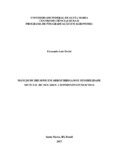| dc.creator | Perini, Fernando Luis | |
| dc.date.accessioned | 2017-09-12T13:58:22Z | |
| dc.date.available | 2017-09-12T13:58:22Z | |
| dc.date.issued | 2017-02-24 | |
| dc.identifier.uri | http://repositorio.ufsm.br/handle/1/11649 | |
| dc.description.abstract | The blast rice, caused of fungus Pyricularia oryzae is the most important rice crop disease and can cause up to 100% crop damage. The cultural, varietal and chemical management at the field level and the monitoring and knowledge of in vitro blast isolates sensitivity are essential tools for better understanding and control of this disease. The objective of this project was to evaluate the effect of the fungicides most used in blast control in three cultivars of irrigated rice in two sowing seasons and to determine in vitro the sensitivity of the mycelial growth of two isolates of P. oryzae to the same fungicides: Triciclazole, Tebuconazole, Azoxystrobin, Trifloxystrobin + Tebuconazole and Casugamycin. For that, an experiment was carried at the field level in the 2015/2016 cropseason in Santa Maria-RS and another experiment in the laboratory. In the first experiment the cultivars used were Guri INTA CL, Puitá INTA CL and IRGA 424 RI sown in the beginning and end of the recommended period and submitted to the same fungicides. The second experiment tested the fungicides at concentrations of 0, 0.01, 0.1, 1, 10 and 100 ppm in two isolates of blast. It was concluded that the cultivar IRGA 424 IR showed to be resistant to blast and that for the maintenance of productive levels in the cultivars susceptible to P. oryzae, especially in the second sowing season, the adoption of more efficient fungicides is indispensable. In relation to mycelial growth in vitro, the first insensitivity of a P. oryzae isolate to the active ingredients Triciclazol and Azoxystrobin was verified at the national level. | eng |
| dc.language | por | por |
| dc.publisher | Universidade Federal de Santa Maria | por |
| dc.rights | Attribution-NonCommercial-NoDerivatives 4.0 International | * |
| dc.rights.uri | http://creativecommons.org/licenses/by-nc-nd/4.0/ | * |
| dc.subject | Pyricularia oryzae | por |
| dc.subject | Oryza sativa L. | por |
| dc.subject | Época de semeadura | por |
| dc.subject | Controle químico | por |
| dc.subject | Sowing season | eng |
| dc.subject | Chemical control | eng |
| dc.title | Manejo de brusone em arroz irrigado e sensibilidade micelial de isolados à diferentes fungicidas | por |
| dc.title.alternative | Management of blast rice in irrigated rice and micelial sensitivy of isolated to different fungicides | eng |
| dc.type | Dissertação | por |
| dc.description.resumo | A brusone, causada pelo fungo Pyricularia oryzae, é a doença mais importante da cultura do arroz, podendo causar até 100% de prejuízos à cultura. O manejo cultural, varietal e químico a nível de campo bem como o monitoramento e conhecimento da sensibilidade in vitro de isolados de brusone, são ferramentas imprescindíveis para o melhor entendimento e controle desta doença. O objetivo deste projeto, foi avaliar o efeito dos fungicidas mais utilizados no controle de brusone, em três cultivares de arroz irrigado, em duas épocas de semeadura e determinar in vitro a sensibilidade do crescimento micelial de dois isolados de P. oryzae aos mesmos fungicidas: Triciclazol, Tebuconazole, Azoxistrobina, Trifloxistrobina + Tebuconazole e Casugamicina. Para tal, foi realizado um experimento em nível de campo na safra 2015/2016 em Santa Maria-RS e outro experimento em laboratório. No primeiro experimento foram utilizadas as cultivares GURI INTA CL, PUITÁ INTA CL e IRGA 424 RI, semeadas no início e no final da época recomendada e essas submetidas aos mesmos fungicidas. O segundo experimento, testou os fungicidas anteriormente citados nas concentrações de 0, 0.01, 0.1, 1, 10 e 100 ppm em dois isolados de brusone. Concluiu-se que a cultivar IRGA 424 RI mostrou-se resistente à brusone e que para a manutenção dos patamares produtivos nas cultivares suscetíveis a P. oryzae, principalmente na segunda época de semeadura, torna-se necessário a adoção de fungicidas mais eficientes. Em relação ao crescimento micelial in vitro, constatou-se à nível nacional, a primeira insensibilidade de um isolado de P. oryzae aos ingredientes ativos Triciclazol e Azoxistrobina. | por |
| dc.contributor.advisor1 | Costa, Ivan Francisco Dressler da | |
| dc.contributor.advisor1Lattes | http://lattes.cnpq.br/6426393869748708 | por |
| dc.contributor.advisor-co1 | Dornelles, Sylvio Henrique Bidel | |
| dc.contributor.advisor-co1Lattes | http://lattes.cnpq.br/7703999212120929 | por |
| dc.contributor.referee1 | Ruviaro, Claiton | |
| dc.contributor.referee1Lattes | http://lattes.cnpq.br/3706288232300725 | por |
| dc.creator.Lattes | http://lattes.cnpq.br/2355224202767528 | por |
| dc.publisher.country | Brasil | por |
| dc.publisher.department | Agronomia | por |
| dc.publisher.initials | UFSM | por |
| dc.publisher.program | Programa de Pós-Graduação em Agronomia | por |
| dc.subject.cnpq | CNPQ::CIENCIAS AGRARIAS::AGRONOMIA | por |
| dc.publisher.unidade | Centro de Ciências Rurais | por |



